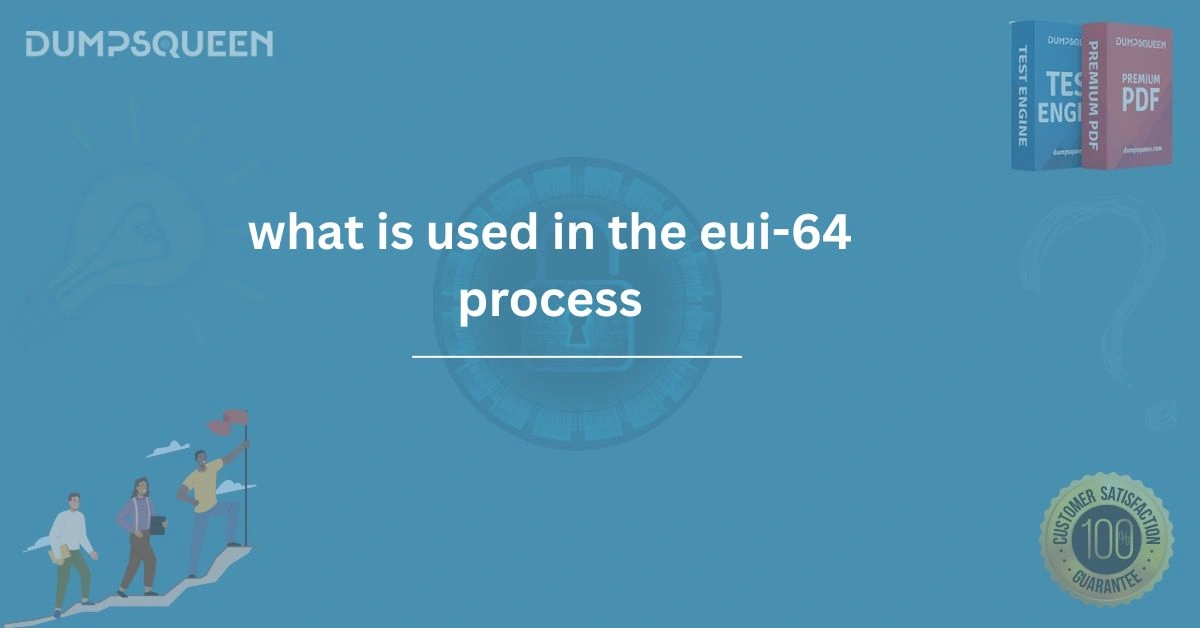Introduction
In the evolving realm of networking and digital communication, IP addressing remains one of the foundational aspects of system-to-system communication. With the advent of IPv6, traditional practices in IP configuration have transformed to support scalability, efficiency, and automation. One such pivotal method in the IPv6 domain is the EUI-64 process. For professionals preparing for networking certifications or anyone interested in deepening their understanding of how IPv6 addresses are generated, the term “EUI-64” becomes a cornerstone topic.The EUI-64 format is primarily used to automatically generate the interface identifier of an IPv6 address by using a device’s MAC address. This method brings automation to the process of IP address configuration, reduces manual errors, and ensures that devices can efficiently generate unique IP addresses without relying on external configuration tools. At DumpsQueen, we ensure that professionals are equipped with the knowledge and resources to tackle such core topics for exams like Cisco’s 200-301 CCNA and other advanced certifications. This blog explores in detail what is used in the EUI-64 process, how it works, and why it matters in modern networking infrastructures. You'll also find a few sample exam-style multiple-choice questions to reinforce your understanding of the concept.
Understanding EUI-64: The Foundation of IPv6 Interface Identifiers
The EUI-64 (Extended Unique Identifier-64) process is a method used within the IPv6 protocol to assign the last 64 bits of an address, known as the interface identifier, in a standardized and unique manner. Traditionally, MAC addresses which are 48-bit identifiers are used as the foundation for creating these 64-bit interface identifiers.In networking, a MAC address serves as a unique identifier for a device on a local network. Since a MAC address is only 48 bits, it cannot directly fill the 64-bit interface identifier portion of an IPv6 address. This is where the EUI-64 process comes into play, converting the 48-bit MAC address into a 64-bit interface identifier.This process ensures that each device, especially those on larger networks, can generate a globally unique IPv6 address using information it already has. This automation is particularly helpful in large-scale environments such as enterprise networks or service provider infrastructures.
The EUI-64 Conversion Process Explained
To understand what is used in the EUI-64 process, it's important to dissect how exactly a 48-bit MAC address is transformed into a 64-bit interface identifier. The steps involve the following components:
-
The MAC Address: The primary input to the EUI-64 process is the device's MAC address. This is what forms the core identity of the device at the data link layer.
-
Splitting the MAC Address: The 48-bit MAC address is first split into two 24-bit halves.
-
Inserting 'FFFE': To expand the address from 48 bits to 64 bits, the hexadecimal sequence
FFFEis inserted in the middle of the two halves. This standardized padding is what enables the expansion. -
Modifying the U/L Bit: The Universal/Local (U/L) bit, which is the seventh bit in the first byte of the MAC address, is inverted (flipped). This bit is used to indicate whether the address is globally unique or locally administered. Changing this bit ensures the address reflects whether it was derived from a MAC address or not.
Let’s say the MAC address is 00:1A:2B:3C:4D:5E. Here's how it would be converted to an EUI-64 identifier:
-
Split the MAC:
00:1A:2Band3C:4D:5E -
Insert FFFE:
00:1A:2B:FF:FE:3C:4D:5E -
Flip U/L bit: The first byte
00(binary:00000000) becomes02(binary:00000010)
The final result: 02:1A:2B:FF:FE:3C:4D:5E
The Purpose and Benefits of Using the EUI-64 Process
Now that we’ve explored how the EUI-64 process works, the question arises: Why is it used? In the world of IPv6, efficiency and scalability are essential. Manual IP address configuration on every device would be a nightmare, especially on enterprise networks where thousands of hosts need connectivity. EUI-64 offers a standardized, automated approach for IP assignment.
Automation and Uniqueness
Using the MAC address ensures that each interface identifier is unique since MAC addresses are designed to be globally unique. This reduces IP conflicts and increases stability within a network.
Simplified Configuration
By leveraging the EUI-64 process, network administrators can simplify the deployment of IPv6 addresses across large numbers of hosts. Devices can autoconfigure themselves without requiring additional servers like DHCPv6.
Integration with SLAAC (Stateless Address Autoconfiguration)
The EUI-64 method is especially important when used alongside SLAAC, which allows devices to automatically generate their IPv6 address by using the prefix advertised by a router and their own interface identifier, created via EUI-64.
Where Is the EUI-64 Process Used?
In real-world networking, the EUI-64 process is primarily used in:
-
IPv6 Autoconfiguration: When devices receive a network prefix from a router, they use the EUI-64 process to complete the IP address.
-
Cisco IOS Configurations: Devices running Cisco operating systems often use this method to generate IPv6 addresses.
-
Networking Labs and Simulations: In exam environments like Cisco’s CCNA or CompTIA Network+, understanding this process is essential for configuring and troubleshooting IPv6 addresses.
At DumpsQueen, our certification preparation content often includes labs, simulations, and practice questions where knowledge of EUI-64 is tested. That’s why our materials emphasize understanding, not just memorization.
Challenges and Security Concerns of EUI-64
While the EUI-64 process is effective for autoconfiguration, it also introduces certain security concerns. Since the interface identifier is derived from the device’s MAC address, it becomes static and predictable. This predictability can be exploited by attackers to track a device across different networks or sessions. To mitigate this, many modern operating systems use privacy extensions or generate randomized interface identifiers to protect user anonymity. Even though EUI-64 remains a valid and widely used method, security-conscious environments might disable it in favor of dynamic, random address generation.
The Role of DumpsQueen in Certification Preparation
Understanding what is used in the EUI-64 process is not just a theoretical exercise it’s a practical requirement for several professional certifications. At DumpsQueen, we understand the significance of mastering such concepts for passing high-stakes exams. Our platform offers verified, up-to-date dumps, practice questions, and study guides for major certification exams including:
-
Cisco 200-301 CCNA
-
CompTIA Network+ (N10-008)
-
Microsoft Azure Administrator
-
AWS Certified Solutions Architect
Whether you're preparing for the CCNA or diving into IPv6 deployment in your enterprise, our study resources ensure you're ready for any scenario practical or exam-based.
Free Sample Questions
Question 1: What is inserted into the middle of a MAC address during the EUI-64 process?
A. FFFF
B. FE80
C. FFFE
D. FFEE
Answer: C. FFFE
Question 2: Which bit is flipped in the EUI-64 process to indicate a universal or local address?
A. The first bit of the MAC address
B. The seventh bit of the first byte
C. The last bit of the second byte
D. The eighth bit of the MAC address
Answer: B. The seventh bit of the first byte
Question 3: Which layer of the OSI model is associated with MAC addresses used in the EUI-64 process?
A. Network
B. Transport
C. Data Link
D. Application
Answer: C. Data Link
Question 4: Why is the EUI-64 process used in IPv6 addressing?
A. To compress IPv4 addresses into IPv6
B. To create a unique 128-bit address using a DNS server
C. To automatically generate the interface identifier portion of an IPv6 address
D. To convert hexadecimal to binary for ARP
Answer: C. To automatically generate the interface identifier portion of an IPv6 address
Conclusion
The EUI-64 process plays a vital role in modern networking, especially in the realm of IPv6. By leveraging a device's MAC address and introducing automation through predictable yet unique transformations, this method ensures efficient and scalable IP addressing. While it may seem like a small technical detail, understanding what is used in the EUI-64 process opens doors to mastering IPv6 deployment and configuration, especially in certification environments like Cisco CCNA. At DumpsQueen, we focus on empowering IT professionals with the knowledge, confidence, and tools they need to excel in certification exams. Our exam dumps, practice tests, and expert resources cover key networking fundamentals such as the EUI-64 process in a practical, exam-ready format. Whether you're preparing for your next certification or simply want to strengthen your networking skills, understanding EUI-64 is a step in the right direction.




